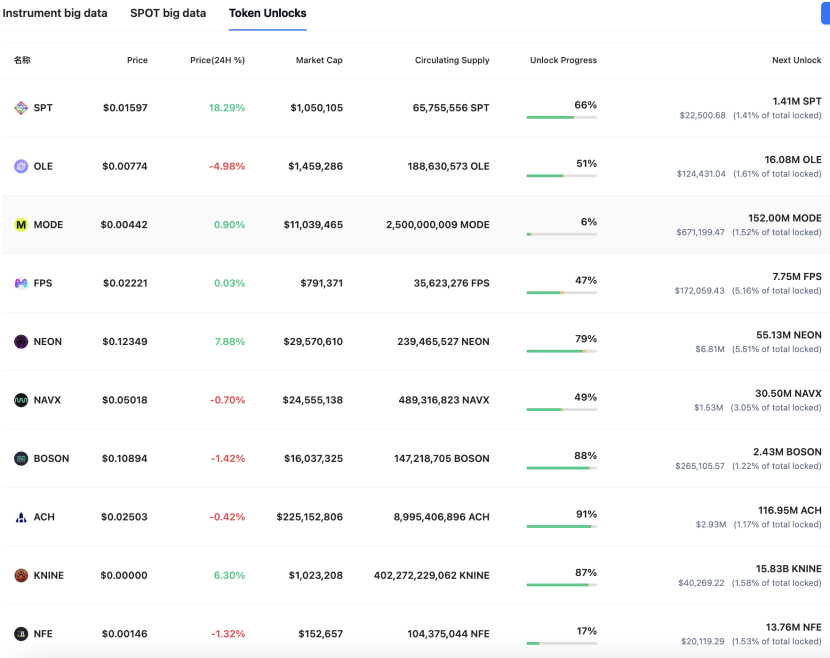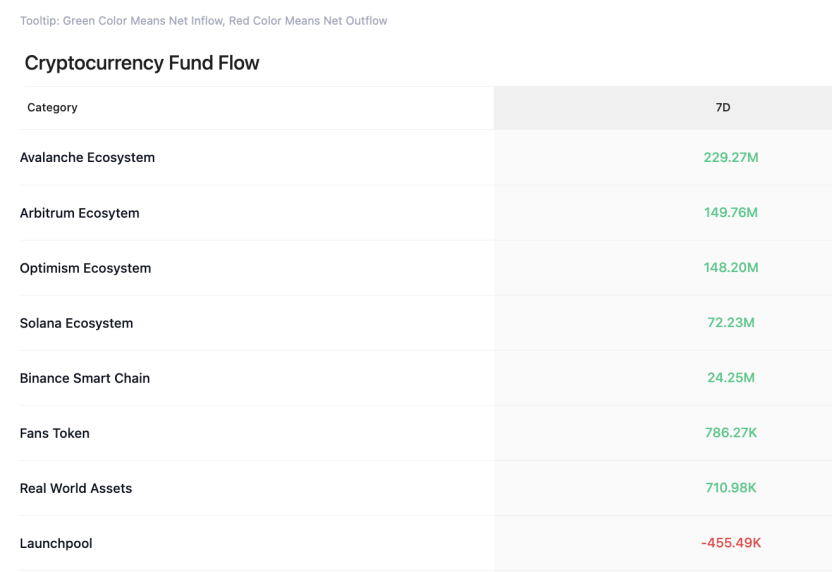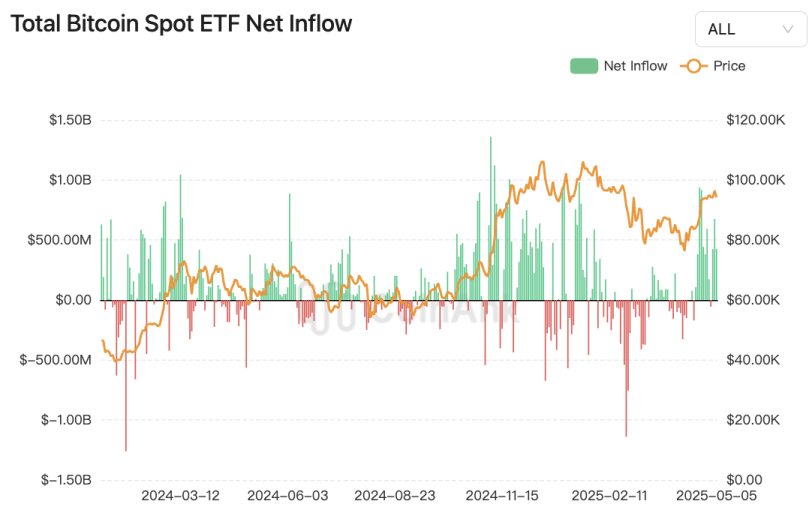This Week's Preview (5.5-5.11), Federal Reserve Interest Rate Decision Approaches, BTC ETF Weekly Inflow Reaches 6 Times Miners' Output!
Table of Contents:
- This week's large token unlock data;
- Overview of the crypto market, quick read on the weekly performance of popular coins/sector fund flows;
- Bitcoin spot ETF dynamics;
- BTC liquidation map data interpretation;
- Key macro events this week and important forecasts and interpretations for the crypto market.
1. This week's large token unlock data;
This week, multiple tokens will undergo a one-time unlock. Sorted by unlock value as follows:
Movement (MOVE) will unlock 50 million tokens on May 9 at 20:00, valued at approximately $8.22 million, accounting for 2% of the circulating supply;
Solayer (LAYER) will unlock 27.02 million tokens on May 11 at 22:00, valued at approximately $78.35 million, accounting for 12.87% of the circulating supply;
Aptos (APT) will unlock 11.31 million tokens on May 13 at 2:00, valued at approximately $55.87 million, accounting for 1.82% of the circulating supply.

The unlocking situation of these projects may have varying degrees of impact on the related markets. The above times are in UTC+8, and the data is from CoinAnk.
We believe that the large unlock events of multiple tokens this week need to be assessed in conjunction with their circulating supply ratios, project fundamentals, and market sentiment to evaluate their potential impact:
MOVE will unlock 50 million tokens on May 9 (accounting for 2% of the circulating supply), valued at approximately $8.22 million. Although the initial unlock may raise community concerns about selling pressure, the unlocked funds are clearly intended for ecological development and community support. If the project can attract developers through the scalability of its modular application chain (such as the technical advantages of connecting EVM and Move ecosystems), short-term selling pressure may be partially offset by market expectations for application implementation. However, the current low circulating supply and high FDV (fully diluted valuation) characteristics still warrant caution regarding the long-term pressure on price from the unlock.
LAYER will unlock 27.02 million tokens on May 11, valued at $78.35 million, accounting for the highest proportion at 12.87% among the three. Such a large-scale concentrated release may significantly increase market supply; if the project lacks short-term positive news (such as ecological progress or partnerships), the token price faces considerable downside risk. Additionally, in the context of a high FDV, investors need to pay attention to whether the recipients of the unlocked tokens (such as teams or institutions) have any motives for selling.
APT will unlock 11.31 million tokens on May 13 (accounting for 1.82% of the circulating supply), valued at $55.87 million. Although the absolute value of the unlock is relatively high, its circulating supply ratio is relatively low, and Aptos has recently seen daily on-chain transaction volumes exceed 300 million, indicating strong ecological activity. The unlock recipients include core contributors, the community, and investors, and the movements of major holders need to be observed. If the unlocked tokens are used for staking or ecological incentives rather than selling, the market impact may be limited. However, it should be noted that APT has historically experienced significant price fluctuations after unlocks, and this should be assessed in conjunction with overall market trends.
Market Insight: Circulating supply management is a key variable; token unlocks are essentially a rebalancing of supply and demand. High circulating supply projects (like APT) have manageable short-term volatility due to sufficient market liquidity; while low circulating supply projects (like LAYER) are more susceptible to price shocks due to weak liquidity. Additionally, unlocks in a bull market may be interpreted by the market as "good news fully priced in," and if the project lacks actual value support, it may face correction pressure post-unlock. Investors should focus on the transparency of the token economic model and the use of unlocked funds, remaining vigilant against the risk of circulating supply manipulation.

2. Overview of the crypto market, quick read on the weekly performance of popular coins/sector fund flows
According to CoinAnk data, over the past week, the crypto market, categorized by concept sectors, saw net inflows in the Avalanche ecosystem, Arbitrum ecosystem, Optimism ecosystem, Solana ecosystem, Binance Smart Contract, fan tokens, and Real World Assets sectors.
In the past 7 days, the top gainers among tokens (selected from the top 500 by market cap) include VRA, FX, ABT, KMNO, and FORM, which should continue to be prioritized for trading opportunities this week.

3. Bitcoin spot ETF fund dynamics.
According to CoinAnk data, last week, the cumulative net inflow into U.S. Bitcoin spot ETFs reached $1.8051 billion, with four trading days showing net inflow. Over the past week, U.S.-listed spot Bitcoin ETFs purchased approximately 18,644 Bitcoins. During the same period, considering the mining efficiency post-Bitcoin halving (approximately 450 Bitcoins per day), global miners produced only about 3,150 Bitcoins. This means that the ETF's purchase volume was nearly 6 times the miners' output during the same period. The total net inflow into Bitcoin ETFs has once again surpassed $40.2 billion, reaching $40.207 billion. The highest total net inflow for Bitcoin ETFs occurred on February 7, reaching $40.78 billion.
We believe that the recent fund inflow data into U.S. Bitcoin spot ETFs reveals a significant imbalance in the market supply-demand structure and the dominant role of institutional investors. The data shows that last week's cumulative net inflow into the ETF, converted to purchase volume, was nearly 6 times that of miners' output. This gap highlights that market demand far exceeds new supply, which may exacerbate expectations of Bitcoin scarcity, thereby supporting the price.
In terms of fund scale, the total net inflow into Bitcoin ETFs has surpassed $40.2 billion, approaching historical peaks (the $40.78 billion on February 7, 2025). BlackRock's IBIT fund continues to lead, reflecting an increasing tendency for institutional investors to allocate Bitcoin through compliant channels. It is worth noting that the ongoing net inflow into ETFs, coupled with the gap between ETF purchases and miners' output, may raise concerns about mid- to long-term liquidity in the market. If demand remains high while supply is constrained by inefficient mining post-halving (approximately 450 Bitcoins per day), the supply-demand conflict may further intensify.
However, the actual impact of ETFs on price is limited. Although the total amount of Bitcoin held by ETFs has exceeded 5% of the circulating supply, historical data shows that fund inflows do not necessarily drive prices to break previous highs. For example, in June 2024, when ETFs saw 18 consecutive days of net inflow, Bitcoin's price was still constrained by macro policies and geopolitical risks. Additionally, some of the funds may originate from arbitrage strategies (such as spot long and futures premium trading), rather than purely bullish expectations. Therefore, the fund dynamics of ETFs need to be assessed in conjunction with the macroeconomic cycle (such as Federal Reserve interest rate policies) and market structure (such as selling pressure from long-term holders).
The activity of Bitcoin ETFs confirms their increasing recognition as a mainstream asset class, but the market should be wary of short-term volatility risks driven by funds and liquidity challenges under supply-demand imbalances. In the future, if ETF fund inflows continue to exceed miners' output, combined with the onset of a rate-cutting cycle, it may provide stronger support for Bitcoin prices to break through.

4. BTC liquidation map data.
CoinAnk liquidation map data shows that if BTC breaks through $97,900, the cumulative short liquidation intensity on major CEXs will reach $4.389 billion. Conversely, if Bitcoin falls below $89,480, the cumulative long liquidation intensity on major CEXs will reach $4.636 billion.
We believe that based on market data and liquidation mechanisms, Bitcoin currently faces significant liquidity risks in key price ranges. If BTC breaks through $97,900, it may lead to a cumulative short liquidation intensity of $4.389 billion on major exchanges, reflecting a concentration of leveraged positions among shorts above this price. A breakthrough could trigger concentrated short covering, pushing prices further up. Conversely, if the price falls below $89,480, the long liquidation intensity will reach $4.636 billion, indicating that longs have accumulated high-risk positions below this support level, and a breach may trigger a chain liquidation and exacerbate the downward trend.
Mechanically, liquidation intensity is not an absolute value but reflects the market vulnerability at specific price ranges. High liquidation intensity means that liquidity distribution near that point is more concentrated, making price breakthroughs likely to trigger a "cascade effect." For example, when shorts are forcefully liquidated at high levels, they need to buy back, potentially creating a positive feedback loop; while forced selling by longs may amplify downward volatility. Current data also shows that as Bitcoin approaches historical highs, the leverage game between longs and shorts has entered a heated stage, and the defense of key levels will directly impact the short-term market direction. It is worth noting that differences in data across different periods (such as discrepancies with threshold values) indicate that the market risk structure will dynamically adjust with price fluctuations, requiring real-time position distribution analysis.
5. Key macro events this week and important forecasts and interpretations for the crypto market.
Monday: U.S. April ISM Non-Manufacturing PMI;
Tuesday: European Central Bank holds a central bank forum until May 7;
Thursday: The Federal Reserve FOMC will announce the interest rate decision at 2:00; Federal Reserve Chairman Powell will hold a monetary policy press conference at 2:30 (UTC+8);
Friday: FOMC permanent voter and New York Fed President Williams will deliver a keynote speech at the 2025 Reykjavik Economic Conference; Federal Reserve Governor Cook will speak; 2025 FOMC voter and Chicago Fed President Goolsbee will deliver a welcome and opening speech at a Federal Reserve event; Federal Reserve Governor Barr will speak.
We believe that the core of this week's macro events lies in the interplay between Federal Reserve policy signals and economic data, which may exacerbate volatility in the crypto market. First, the U.S. April ISM Non-Manufacturing PMI rose to 51.6, a two-year high, indicating that service sector expansion exceeded expectations, with the price index jumping to 65.1, suggesting rising inflationary pressures. This data may reinforce the necessity for the Federal Reserve to maintain a hawkish stance, suppressing market bets on rate cuts, thereby exerting short-term pressure on crypto assets.
Thursday's FOMC interest rate decision and Powell's press conference are particularly critical. Historical experience shows that Powell's dovish or hawkish inclinations directly affect market sentiment; for example, in 2024, after he signaled a rate cut, crypto assets surged in a single day, while hawkish statements triggered sell-offs. If this meeting raises concerns about persistent inflation or delays signals for rate cuts, it may trigger a correction in the crypto market. Conversely, if risks of economic slowdown are mentioned, it may alleviate expectations of liquidity tightening, becoming a short-term bullish factor.
Additionally, the concentrated speeches from several Federal Reserve officials on Friday may convey signals of divergence. If the statements from "permanent voters" like Williams lean towards tightening, it may offset Powell's potentially dovish remarks, leading to market expectation confusion. Currently, the crypto market is strongly correlated with U.S. stocks, and changes in liquidity expectations may amplify volatility.
In summary, strong PMI data has provided support for the Federal Reserve's "higher for longer" interest rate policy, and the crypto market may face short-term correction pressure. However, if Powell unexpectedly releases dovish signals, it may trigger short covering. It is advisable to pay attention to subtle changes in policy language and real-time shifts in market sentiment indicators.
免责声明:本文章仅代表作者个人观点,不代表本平台的立场和观点。本文章仅供信息分享,不构成对任何人的任何投资建议。用户与作者之间的任何争议,与本平台无关。如网页中刊载的文章或图片涉及侵权,请提供相关的权利证明和身份证明发送邮件到support@aicoin.com,本平台相关工作人员将会进行核查。



